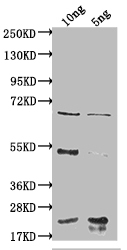Full Product Name
Rabbit anti-Escherichia coli (strain K12) degP Polyclonal antibody
Alternative Names
degP antibody; htrA antibody; ptd antibody; b0161 antibody; JW0157 antibody; Periplasmic serine endoprotease DegP antibody; EC 3.4.21.107 antibody; Heat shock protein DegP antibody; Protease Do antibody
Species Reactivity
Escherichia coli
Immunogen
Recombinant Escherichia coli Periplasmic serine endoprotease DegP (degP) (27-474AA)
Immunogen Species
Escherichia coli (strain K12)
Purification Method
Protein A/G
Concentration
It differs from different batches. Please contact us to confirm it.
Buffer
Preservative: 0.03% Proclin 300
Constituents: 50% Glycerol, 0.01M PBS, pH 7.4
Tested Applications
ELISA, WB
Storage
Upon receipt, store at -20°C or -80°C. Avoid repeated freeze.
Lead Time
Basically, we can dispatch the products out in 1-3 working days after receiving your orders. Delivery time maybe differs from different purchasing way or location, please kindly consult your local distributors for specific delivery time.
Description
The degP antibody is meticulously generated through rabbit immunization with recombinant Escherichia coli Periplasmic serine endoprotease degP (27-474aa), which triggers the production of IgG antibodies by the rabbit's B lymphocytes. Afterward, the polyclonal degP antibody undergoes rigorous purification through protein A/G methods. This degP antibody is a reliable tool for the detection of Escherichia coli degP protein in ELISA and WB experiments.
The Escherichia coli periplasmic serine endoprotease degP mainly functions as an ATP-independent heat shock protease with both protease and chaperone activities, mediating proteolytic quality control of periplasmic proteins under acid stress and constituting an unprecedented degradation pathway in facilitating bacterial acid resistance.
Usage
For Research Use Only. Not for use in diagnostic or therapeutic procedures.







